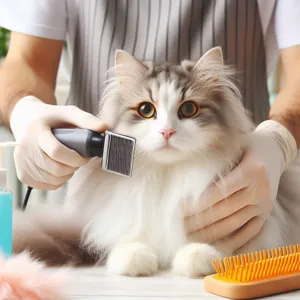Grooming a long-haired cat can often feel like a daunting task, but it’s essential for maintaining their health and beauty.
These fluffy companions, with their luxurious coats and endearing personalities, require a little extra TLC to prevent mats, tangles, and skin issues. As a devoted cat owner, you want nothing but the best for your feline friend, and mastering the art of grooming is key to keeping them looking and feeling their best. In this comprehensive guide, we’ll share essential tips and tricks that will empower you to groom your long-haired cat like a pro. From choosing the right tools and understanding proper brushing techniques to tackling those tricky knots and promoting a stress-free grooming experience, you’ll be equipped with everything you need to turn grooming time into a bonding moment filled with love and care. So grab your grooming supplies, and let’s dive into the world of feline pampering!
1. Understanding Your Long-Haired Cat’s Coat

Understanding your long-haired cat’s coat is the first step toward mastering the art of grooming. Unlike their short-haired counterparts, long-haired cats boast a luxurious, flowing mane that can be both stunning and demanding. Their coats come in a variety of textures and colors, from silky Persians to fluffy Maine Coons, each requiring a tailored grooming approach.
The coat of a long-haired cat consists of multiple layers, typically featuring an undercoat and a topcoat. The undercoat is soft and dense, providing insulation, while the topcoat consists of longer, guard hairs that protect against dirt and moisture. This unique structure can make long-haired cats prone to matting, tangles, and excessive shedding if not addressed regularly.
Regular brushing is essential to prevent these issues. Ideally, you should aim for at least two to three grooming sessions each week, using a high-quality slicker brush or a wide-toothed comb to delicately detangle any knots and remove loose fur. Pay special attention to the areas behind the ears, under the chin, and around the hindquarters, where mats often form.
Additionally, understanding your cat’s specific grooming needs can help you choose the right tools and products. Some long-haired breeds may benefit from specialized shampoos or conditioners designed to enhance their coat’s shine and manageability. Observing your cat’s behavior and coat condition will guide you in developing a grooming routine that keeps their fur healthy and vibrant.
By investing time to understand your long-haired cat’s coat, you’ll not only enhance their beauty but also contribute to their overall health and happiness, ensuring they feel as fabulous as they look!
2. The Importance of Regular Grooming
Regular grooming is not just a luxury for long-haired cats; it’s a vital aspect of their overall health and well-being. For these majestic felines, their flowing coats are a point of pride, but they also require a commitment to maintenance that goes beyond the occasional brush. Long-haired cats are particularly prone to matting, tangles, and hairballs, which can lead to discomfort and even health issues if not addressed promptly.
When you groom your cat regularly—ideally several times a week—you prevent knots from forming in their fur. These mats can pull on the skin and create painful hotspots or even lead to skin infections if left unattended. Moreover, brushing your cat helps to distribute natural oils throughout their coat, promoting a shiny, healthy appearance that showcases their beauty.
But grooming isn’t just about the practical aspects; it also fosters a deeper bond between you and your feline friend. The act of grooming can be a soothing ritual for both of you, allowing your cat to relax as you gently work through their fur. This close contact not only reassures your pet but also gives you the opportunity to check for any unusual signs, like lumps or skin irritations, that may require veterinary attention.
Additionally, regular grooming reduces shedding and minimizes the amount of hair that ends up on your furniture and clothing—an added bonus for maintaining a clean home! By establishing a consistent grooming routine, you’re not only investing in your cat’s health but also enhancing your shared living environment. So grab your brush, find a cozy spot, and make grooming a delightful part of your long-haired cat’s life!
3. Essential Grooming Tools for Long-Haired Cats

When it comes to grooming your long-haired cat, having the right tools can make all the difference between a pleasant experience and a frustrating one. Here are the essential grooming tools you should have in your arsenal to ensure your feline friend looks and feels their best.
**1. High-Quality Slicker Brush:**
A slicker brush is a must-have for any long-haired cat owner. Its fine, short wires help untangle knots and remove loose fur without damaging your cat’s delicate skin. Regular brushing with a slicker brush not only prevents matting but also reduces shedding, keeping your home fur-free.
**2. Wide-Toothed Comb:**
Once you’ve tackled the tangles with a slicker brush, follow up with a wide-toothed comb. This tool is perfect for gently detangling any remaining knots, especially around sensitive areas like the ears and underbelly. The wide teeth help to glide through the fur smoothly, reducing breakage and discomfort.
**3. De-shedding Tool:**
For those particularly fluffy cats, a de-shedding tool is invaluable. These specialized tools reach beneath the topcoat to remove loose undercoat fur, helping to minimize shedding and hairballs. Use it during your regular grooming sessions to keep your cat’s coat healthy and reduce the amount of fur floating around your home.
**4. Nail Clippers:**
Don’t forget about those claws! Keeping your cat’s nails trimmed is essential for their health and comfort. Invest in a high-quality pair of cat nail clippers or a nail grinder designed for feline paws. Regular nail maintenance will prevent scratching and keep your kitty comfortable as they roam around.
**5. Cat-Safe Shampoo:**
Bath time may not be your cat’s favorite activity, but having a good cat-safe shampoo on hand can make it easier. Look for gentle, hypoallergenic formulas that cater specifically to long-haired cats. Regular bathing can help keep their coat clean and free of allergens, especially if they spend time outdoors.
**6. Grooming Gloves:**
For those cats who are a bit skittish about traditional grooming tools, grooming gloves can be a game-changer. These gloves allow you to groom your cat while petting them, providing a gentle touch that feels more like a cuddle than a chore. The rubber tips help to remove loose fur and can also stimulate your cat’s skin, promoting healthy circulation.
By equipping yourself with these essential grooming tools, you’ll not only make the grooming process smoother but also strengthen the bond between you and your long-haired companion. Regular grooming is a key component of their overall well-being, ensuring they feel comfortable and look fabulous every day!
4. Creating a Comfortable Grooming Environment
Creating a comfortable grooming environment is crucial for both you and your long-haired feline companion. Cats, especially those with luxurious coats, can be sensitive to their surroundings, and a stress-free atmosphere can make all the difference in their grooming experience. Start by selecting a quiet, well-lit area where you can work without distractions. A cozy corner of your living room or a calm space in a sunlit bathroom can serve as the perfect grooming station.
Consider using a non-slip mat or a soft blanket on the surface where you’ll be grooming your cat. This not only provides a secure footing for your pet but also adds a touch of comfort. Cats love warmth, so if your cat enjoys cozy spots, placing a heated pad or a warm towel underneath can help them feel more relaxed and at ease.
Next, ensure that all your grooming tools are within arm’s reach. Having everything organized will minimize movement and potential stress for your furry friend. Tools like brushes, combs, nail clippers, and even treats should be at the ready to keep the session smooth and enjoyable.
Incorporate calming elements into your grooming routine as well. Soft background music or the gentle sound of a white noise machine can create a soothing atmosphere that helps reduce anxiety. Additionally, consider using pheromone sprays or diffusers designed for cats to help promote a sense of calm during grooming.
Lastly, never underestimate the power of positive reinforcement. Before you begin grooming, spend a few moments petting and soothing your cat, letting them know that this experience will be enjoyable. Offer treats or gentle praise throughout the session to reinforce good behavior and create a positive association with grooming. By cultivating a comfortable environment, you’ll transform grooming from a chore into a bonding experience that your long-haired cat will look forward to!
5. Step-by-Step Grooming Process

Grooming your long-haired cat may seem daunting, but with a structured step-by-step approach, you can transform the experience into an enjoyable bonding session for both you and your feline friend. Here’s how to master the art of cat grooming like a pro!
**Step 1: Gather Your Supplies**
Before diving into the grooming process, make sure you have all the necessary tools at your disposal. You’ll need a quality slicker brush, a wide-toothed comb, cat-safe scissors for trimming, nail clippers, and a gentle shampoo if you’re planning on giving your kitty a bath. Having everything ready will make the grooming session smoother and more efficient.
**Step 2: Create a Calm Environment**
Choose a quiet, comfortable space where your cat feels safe. This could be a cozy corner of your living room or a designated grooming area. Consider using a non-slip mat to provide traction for your cat. Before you begin, take a moment to pet your cat and let them settle into the space, ensuring they are relaxed and ready for the grooming session.
**Step 3: Brush to Remove Tangles and Mats**
Start by gently brushing your cat’s coat with the slicker brush. Begin at the head and work your way toward the tail, using short, gentle strokes. Pay extra attention to areas prone to matting, such as behind the ears, under the legs, and around the collar. If you encounter any mats, hold the base of the fur to avoid pulling on the skin, and carefully work them out with the wide-toothed comb. For stubborn mats, you may need to use the scissors, but be extremely cautious to avoid harming your cat.
**Step 4: Inspect and Trim**
Once you’re satisfied with the brushing, take a close look at your cat’s coat and skin. Look for any signs of irritation, parasites, or unusual lumps. If you spot any issues, consult your veterinarian. If your cat has excessively long fur around their paws or rear end, gently trim the hair to keep it manageable and hygienic. Always use cat-specific scissors and work slowly to prevent accidents.
**Step 5: Nail Care**
Next, it’s time to tackle the nails. Gently hold one paw at a time and press slightly on the pad to extend the claw. Trim only the sharp tip of the claw, avoiding the pink area known as the quick. If your cat is anxious, consider using a cat nail grinder instead of clippers, as this can be less stressful for them.
**Step 6: Bath Time (Optional)**
If your cat is particularly dirty or has a strong odor, consider giving them a bath. Use lukewarm water and a cat-safe shampoo, lathering gently while avoiding their face. Rinse thoroughly and wrap them in a soft towel to dry.
**Step 7: Reward and Bond**
After grooming, reward your cat with treats or engage in playtime to create a positive association with the grooming process. This not only reinforces good behavior but also strengthens the bond between you and your furry companion.
By following these steps, grooming your long-haired cat can become a simple and enjoyable routine. With patience and practice, you’ll not only keep your cat looking fabulous but also ensure they feel loved and cared for!
6. Brushing Techniques for Different Coat Types
When it comes to grooming your long-haired cat, understanding the specific brushing techniques tailored to their unique coat type can make all the difference. Each coat type has its own set of needs, and mastering these techniques ensures that your feline friend remains comfortable, healthy, and looking fabulous.
**1. Silky and Fine Coats:** For cats with silky, fine fur, a wide-toothed comb is your best friend. Start by gently detangling any knots, working from the tips of the fur towards the roots. This approach minimizes pulling on the skin, which can be uncomfortable for your cat. Once you’ve removed any tangles, switch to a soft-bristle brush to smooth the coat and enhance its natural shine. A light touch is key, as too much pressure can irritate their sensitive skin.
**2. Thick and Dense Coats:** For those cats boasting a thick, plush coat, a slicker brush is essential. Begin by using the slicker brush to reach through the dense fur, removing loose hair and mats. Be sure to work in sections, starting from the back and moving towards the head. After addressing tangles and mats, follow up with a wide-toothed comb to ensure a thorough grooming session. This technique not only keeps their coat looking pristine but also reduces shedding around your home.
**3. Wavy or Curly Coats:** If your cat has a wavy or curly coat, consider using a comb specifically designed for curly fur. These combs have longer teeth that can glide through the curls without disrupting their natural wave. Start from the base of the fur and work your way up, gently separating the curls to avoid breakage. After combing, a bristle brush can help smooth out the fur and give it a polished finish.
**4. Mats and Tangles:** Regardless of the coat type, mats can be a common issue for long-haired cats. Always approach mats with caution. Use your fingers to gently loosen the fur, and if you encounter a stubborn mat, a dematting tool can work wonders. For particularly tough tangles, consider applying a small amount of cat-safe detangling spray to ease the process. Remember, patience is crucial; never yank or pull on mats, as this can cause pain and stress.
By tailoring your brushing techniques to your cat’s specific coat type, you not only enhance their coat’s appearance but also contribute to their overall well-being. Regular grooming sessions help reduce the risk of skin issues, keep your home hair-free, and strengthen the bond between you and your furry companion. With the right tools and techniques, you’ll be well on your way to grooming your long-haired cat like a pro!
7. Dealing with Mats and Tangles

Grooming a long-haired cat can be a labor of love, especially when it comes to tackling those pesky mats and tangles that seem to spring up out of nowhere. The first step in this delicate dance is to remain calm and gentle, as your furry friend can easily become stressed during grooming sessions. Start by assessing the extent of the tangles. If you spot a small mat, you may be able to work it out with your fingers or a wide-toothed comb. Gently tease the mat apart, starting from the outer edges and working your way in, being careful not to pull on your cat’s skin.
For more stubborn mats or those that have formed closer to the skin, a specialized dematting tool can be your best ally. These tools are designed to cut through the matting without causing discomfort to your pet. However, if you encounter a particularly large or tight mat, it might be worth considering a visit to a professional groomer. They have the experience and tools to safely remove the matting without causing pain or stress to your cat.
Preventative care is just as important as the treatment of existing tangles. Regular brushing is essential for long-haired cats, ideally a few times a week or even daily, depending on your cat’s coat type. Use a slicker brush or a pin brush to help prevent mats from forming in the first place. Pay special attention to areas where mats tend to develop, such as behind the ears, under the legs, and around the collar area. Additionally, incorporating a healthy diet rich in omega fatty acids can promote a smoother coat, reducing the likelihood of tangling.
Finally, remember that grooming should be a positive experience for your cat. Reward them with treats and praise throughout the process to create a sense of comfort and trust. With patience and regular care, you can keep your long-haired feline looking fabulous and free of mats, ensuring they feel as good as they look!
8. Bathing Your Long-Haired Cat: When and How
Bathing your long-haired cat is a topic that often stirs up a mix of apprehension and curiosity among feline owners. Unlike our canine companions, cats are generally self-groomers, but there are times when a bath becomes necessary—especially for long-haired breeds that are prone to matting, tangles, and occasional skunk encounters. So, when should you consider giving your furry friend a bath?
Ideally, you should bathe your long-haired cat only when absolutely needed. This could be after they’ve rolled in something unsavory, or if they have developed mats that can’t be gently brushed out. It’s also worth considering a bath during shedding seasons, as this can help remove loose fur and minimize hairballs. Generally, a good rule of thumb is to bathe your cat every 4 to 6 months, but always pay attention to their individual grooming needs.
Now, let’s talk about the “how.” Prepare the bathing area in advance, ensuring you have all your supplies within arm’s reach. You’ll need a cat-friendly shampoo, a non-slip mat for the bottom of the sink or tub, towels for drying, and perhaps a handheld sprayer or cup for rinsing. It’s crucial to use a shampoo specifically formulated for cats, as human products can irritate their skin.
When it’s time to bathe, fill the tub or sink with a few inches of lukewarm water—just enough to submerge your cat’s feet without overwhelming them. Gently place your cat in the water, supporting their body with one hand to help them feel secure. Use the other hand to wet their fur gradually, avoiding their face. Lather the shampoo into their coat, taking care to massage it well into any matted areas, but be gentle to avoid causing stress or discomfort.
Rinse thoroughly, ensuring that no shampoo residue remains, as this can lead to skin irritation. Once they’re clean, wrap your cat in a towel and gently pat them dry—avoid vigorous rubbing, which can tangle their fur further. If your cat tolerates it, you might consider using a low-heat setting on a pet-safe blow dryer from a distance, but many cats prefer to air dry in a cozy, warm spot.
Remember, patience is key! Some cats will adapt to baths better than others, so take your time, talk soothingly to your feline friend, and turn bath time into a bonding experience. With the right approach, bathing your long-haired cat can be a manageable task that leaves them not just looking, but feeling their absolute best.
9. Nail Trimming Tips for Long-Haired Cats
Nail trimming can be a daunting task for many cat owners, especially when it comes to long-haired breeds. However, keeping your feline’s claws in check is essential for their health and well-being, not to mention the safety of your furniture and skin! Here are some pro tips to ensure the process goes smoothly for both you and your fluffy companion.
**1. Choose the Right Tools:** Start by investing in a pair of high-quality cat nail clippers or guillotine-style trimmers specifically designed for pets. A pair of human nail clippers can be too large and unwieldy for your cat’s delicate claws. Additionally, having a nail file or grinder on hand can help smooth out any sharp edges after clipping.
**2. Create a Calm Environment:** Set up a quiet, comfortable space free from distractions. This will help both you and your cat feel more relaxed during the grooming session. Consider using a cozy blanket or their favorite spot, as it can offer a sense of security.
**3. handle with Care:** Before you even bring out the clippers, spend some time handling your cat’s paws to get them used to the sensation. Gently press on their paws to expose the claws and reward them with treats or praise for their cooperation. This will help reduce anxiety during the actual trimming process.
**4. Trim Wisely:** When trimming, look for the pink area within the claw known as the quick. Avoid cutting into this sensitive part, as it can cause pain and bleeding. If your cat has dark claws and the quick is not visible, trim just the sharp tip. If you’re uncertain, it’s better to err on the side of caution and trim less.
**5. Take Breaks as Needed:** If your cat becomes agitated or restless, take a break and allow them to relax. You can always split the session into smaller segments over a few days, especially if your cat is particularly sensitive or unaccustomed to nail trimming.
**6. Reward and Praise:** After each successful trim, shower your cat with affection and treats. This positive reinforcement will help them associate nail trimming with a pleasant experience, making future grooming sessions easier and more enjoyable.
By following these nail trimming tips, you’ll ensure that your long-haired cat remains comfortable and well-groomed. Not only will this contribute to their overall health, but it will also strengthen the bond between you and your feline friend. With a little patience and practice, you’ll become a pro at keeping those adorable paws perfectly pampered!
10. Ear and Eye Care Basics
When it comes to grooming your long-haired cat, ear and eye care are often overlooked but are crucial aspects of maintaining your feline’s overall health and comfort. Regular attention to these areas not only keeps your cat looking its best but also prevents potential health issues that can arise from neglect.
**Ear Care:** Start with your cat’s ears, which can accumulate dirt, wax, and debris over time. Gently inspect the inner ear for any signs of excessive wax buildup, redness, or foul odors, as these could indicate infections that require veterinary attention. To clean your cat’s ears, use a soft, damp cloth or a veterinarian-recommended ear cleaning solution. Avoid inserting anything deep into the ear canal; instead, focus on gently wiping the outer ear and the area where the ear meets the head. If your cat resists this process, consider incorporating it into a regular routine, rewarding them with treats or praise to create a positive association.
**Eye Care:** Next, turn your attention to your cat’s eyes. Long-haired breeds are particularly prone to tear staining, which can affect their beautiful appearance. Use a soft, damp cloth or a specialized eye wipe to gently wipe away any discharge that may accumulate around the eyes. Be sure to use a different section of the cloth for each eye to prevent cross-contamination. If you notice persistent tearing or changes in your cat’s eye health, such as redness or cloudiness, consult your veterinarian for further evaluation.
By incorporating these simple ear and eye care routines into your grooming sessions, you’ll not only keep your long-haired cat looking fabulous but also ensure they feel their best. A well-groomed cat is a happy cat, and your diligent care will strengthen the bond you share with your furry companion.
11. Identifying Skin Issues and Allergies
Grooming a long-haired cat goes beyond brushing and trimming; it also involves keen observation of your feline friend’s skin health. Identifying skin issues and allergies early on can prevent discomfort and more serious health complications down the line. As you groom your cat, take the time to inspect their skin closely. Look for signs such as redness, inflammation, or unusual bumps that could indicate underlying issues.
Pay attention to areas where matting may occur, as the skin underneath can be prone to irritation and infections if not properly cared for. If you notice excessive scratching, biting, or grooming in specific areas, this could be a sign of allergies or skin conditions that may require veterinary attention. Common culprits include fleas, food allergies, or environmental allergens like pollen and dust mites.
Additionally, keep an eye out for any changes in the texture or smell of your cat’s fur, as these can also signal skin problems. A healthy coat should be sleek and shiny, while excessive oiliness or a dull appearance may indicate an issue. Remember, grooming sessions can double as a valuable opportunity for bonding with your cat while ensuring they remain healthy and comfortable. If you suspect any skin issues or allergies, consult with a veterinarian to discuss potential treatments or dietary adjustments. By being proactive and attentive, you can help your long-haired cat maintain not just their beautiful coat, but their overall well-being, too.
12. Incorporating Grooming into Your Cat’s Routine
Incorporating grooming into your long-haired cat’s routine is essential for both their health and happiness. Cats thrive on consistency, and when grooming becomes a regular part of their daily life, it fosters trust and reduces anxiety around the process. Start by establishing a comfortable environment; choose a quiet spot with minimal distractions where your cat feels secure, perhaps a favorite sunny window perch or a cozy blanket.
Begin with short grooming sessions, gradually increasing the duration as your cat becomes accustomed to the activity. Use high-quality grooming tools, such as a slicker brush for detangling and a wide-toothed comb for smoothing out the fur. Introduce these tools slowly, allowing your cat to sniff and explore them before use. You can make grooming a positive experience by offering treats and praise throughout the process, reinforcing good behavior and creating a sense of reward.
To further integrate grooming into your cat’s routine, consider setting specific days or times for grooming sessions, such as every Wednesday and Saturday afternoon. This not only helps you stay organized but also allows your cat to anticipate the routine. By associating grooming with pleasant experiences, you’ll help your feline friend view it as a bonding time rather than a chore.
Additionally, keep an eye on your cat’s skin and coat condition during grooming. Look for signs of mats, skin irritations, or parasites. Early detection can prevent more significant issues down the line. Regular grooming not only keeps your cat looking fabulous but also contributes to their overall well-being, making it a win-win for both of you. With patience and persistence, you’ll soon be grooming your long-haired companion like a pro!
13. Positive Reinforcement During Grooming
When it comes to grooming your long-haired feline friend, incorporating positive reinforcement can transform the experience from a potential struggle into a delightful bonding activity. Cats, especially those with long, flowing coats, can be quite sensitive to grooming sessions, often associating them with stress or discomfort. However, by using positive reinforcement techniques, you can help your furry companion learn to enjoy the process.
Start by creating a calm and inviting atmosphere. Choose a quiet space free from distractions, and make sure your cat feels secure. As you begin to groom, keep a stash of their favorite treats nearby—these will be your secret weapon. Each time you gently brush a section of their coat or successfully detangle a knot, offer a small treat along with plenty of praise. This not only rewards good behavior but also helps your cat associate grooming with something positive.
Be mindful of your cat’s body language throughout the grooming process. If you notice signs of distress—such as twitching tails, flattened ears, or attempts to escape—take a step back. Respect their boundaries by allowing breaks and giving them a chance to relax. During these pauses, offer gentle petting and soothing words, reinforcing the idea that grooming is a nurturing experience.
Consistency is key; make grooming a regular part of your cat’s routine, gradually increasing the duration as they become more comfortable. Over time, your long-haired companion will begin to look forward to these sessions, eagerly anticipating the treats and affection that come with them. By employing positive reinforcement, you’ll not only keep your cat’s coat healthy and tangle-free but also strengthen the bond between you, making grooming a cherished time for both of you.
14. Professional Grooming: When to Consider It
While regular grooming at home is essential for maintaining your long-haired cat’s luscious coat, there are times when seeking the expertise of a professional groomer can make all the difference. If you find yourself overwhelmed by your feline’s grooming needs, or if your cat exhibits any anxiety or resistance to being groomed, it may be time to consider professional help.
Professional groomers possess specialized tools and techniques that can address issues beyond the reach of standard home grooming. For instance, if your cat has developed mats or tangles that are too stubborn to remove, a groomer can carefully detangle or shave those areas, ensuring your cat’s comfort and appearance. Additionally, if your furry friend has specific health conditions, such as arthritis or obesity, a groomer can accommodate their needs, providing a gentler grooming experience that you may not be able to replicate at home.
Moreover, if you notice excessive shedding or changes in your cat’s coat quality, a professional groomer can offer insights and treatments that may enhance your cat’s overall coat health. They can also provide valuable advice on the best grooming products tailored for your cat’s unique fur type, as well as tips on maintaining a regular grooming routine at home.
Ultimately, professional grooming can be a fantastic complement to your at-home efforts, ensuring that your long-haired companion stays looking fabulous and feeling comfortable. If your cat’s grooming needs are beyond your expertise—or if you simply want the peace of mind that comes from knowing they are in skilled hands—don’t hesitate to book a session with a trusted groomer. It’s an investment in your cat’s health and happiness that can pay off in spades!
15. Final Thoughts: Building a Bond Through Grooming
Grooming your long-haired cat is about so much more than just maintaining a beautiful coat; it’s an opportunity to forge a deeper connection with your feline friend. As you spend time brushing, bathing, and caring for their fur, you also create moments of trust and affection that can enhance your relationship. Cats, despite their reputation for independence, thrive on routine and familiarity. By incorporating grooming into your regular interactions, you signal to your cat that they are loved and cared for, fostering a sense of security.
Take a moment to observe your cat’s reactions during grooming sessions. Pay attention to their body language—do they lean into the brush, purr softly, or settle comfortably in your lap? These cues indicate that they appreciate the attention and the bonding experience. Use this time to speak softly to them, offering gentle praise and treats to reinforce positive associations with grooming.
Additionally, grooming can be a form of play. Introduce toys or engage in light games before or after grooming sessions to keep the mood light and enjoyable. This not only makes grooming less of a chore but also turns it into a rewarding experience for both of you.
Remember that patience is key—some cats may be more sensitive or resistant to grooming than others. Take your time, and be mindful of your cat’s comfort level. As you both grow accustomed to this ritual, you’ll find that these moments become cherished part of your daily routine, strengthening the bond you share. So, grab that brush, take a deep breath, and enjoy the journey of grooming together. Your long-haired companion will thank you with every purr and nuzzle!
In conclusion, grooming your long-haired cat doesn’t have to be a daunting task; with the right techniques and tools, you can transform this necessity into a bonding experience for both you and your feline companion. By following the essential tips outlined in this post—whether it’s mastering the art of detangling, selecting the right brushes, or establishing a calming grooming routine—you’ll not only keep your cat looking fabulous but also enhance their overall health and happiness. Remember, patience and consistency are key, so take your time and enjoy these moments of connection. We encourage you to share your grooming successes and any additional tips you might have learned along the way. Happy grooming, and may your cat’s coat shine as brightly as their personality!






